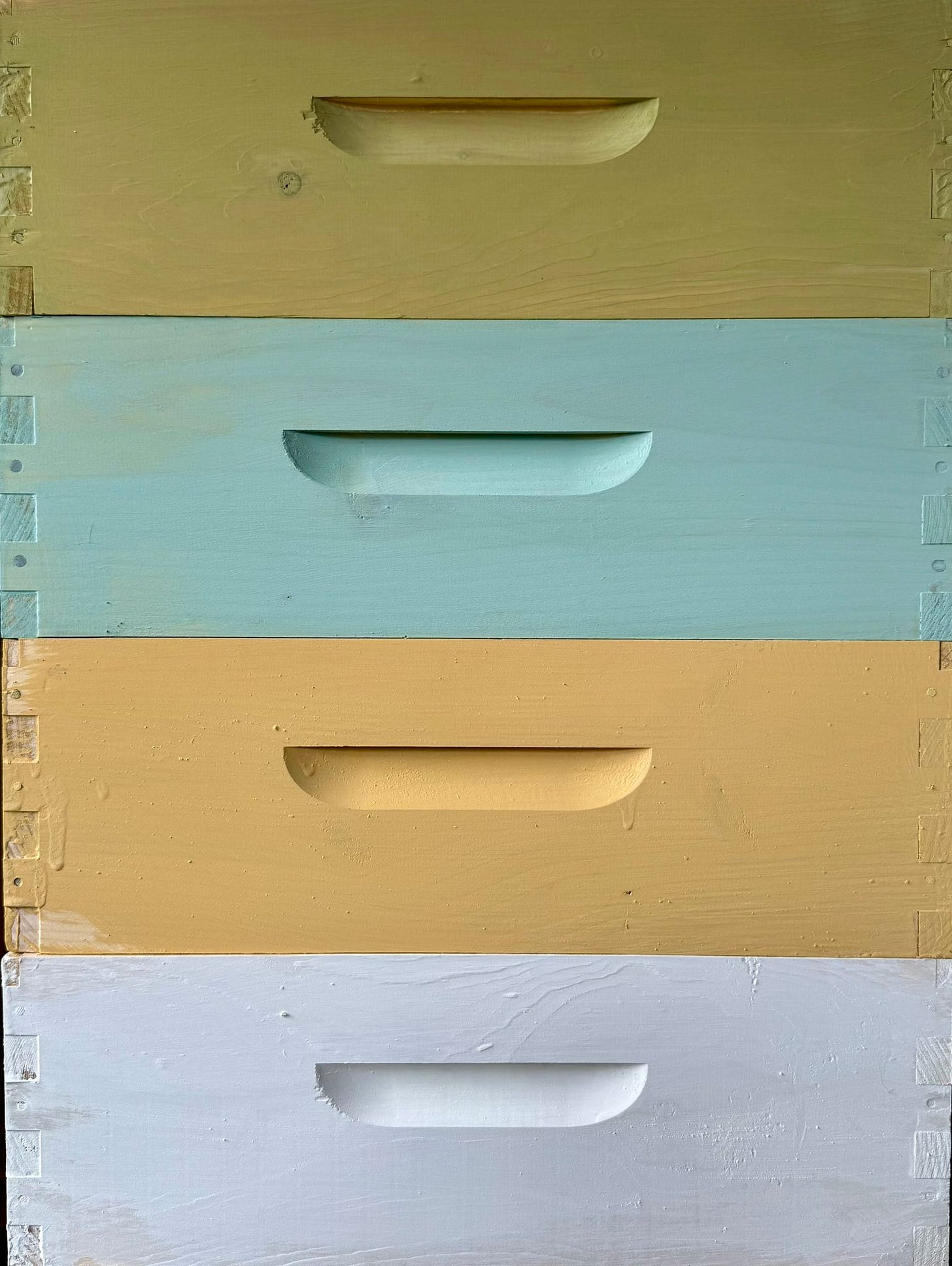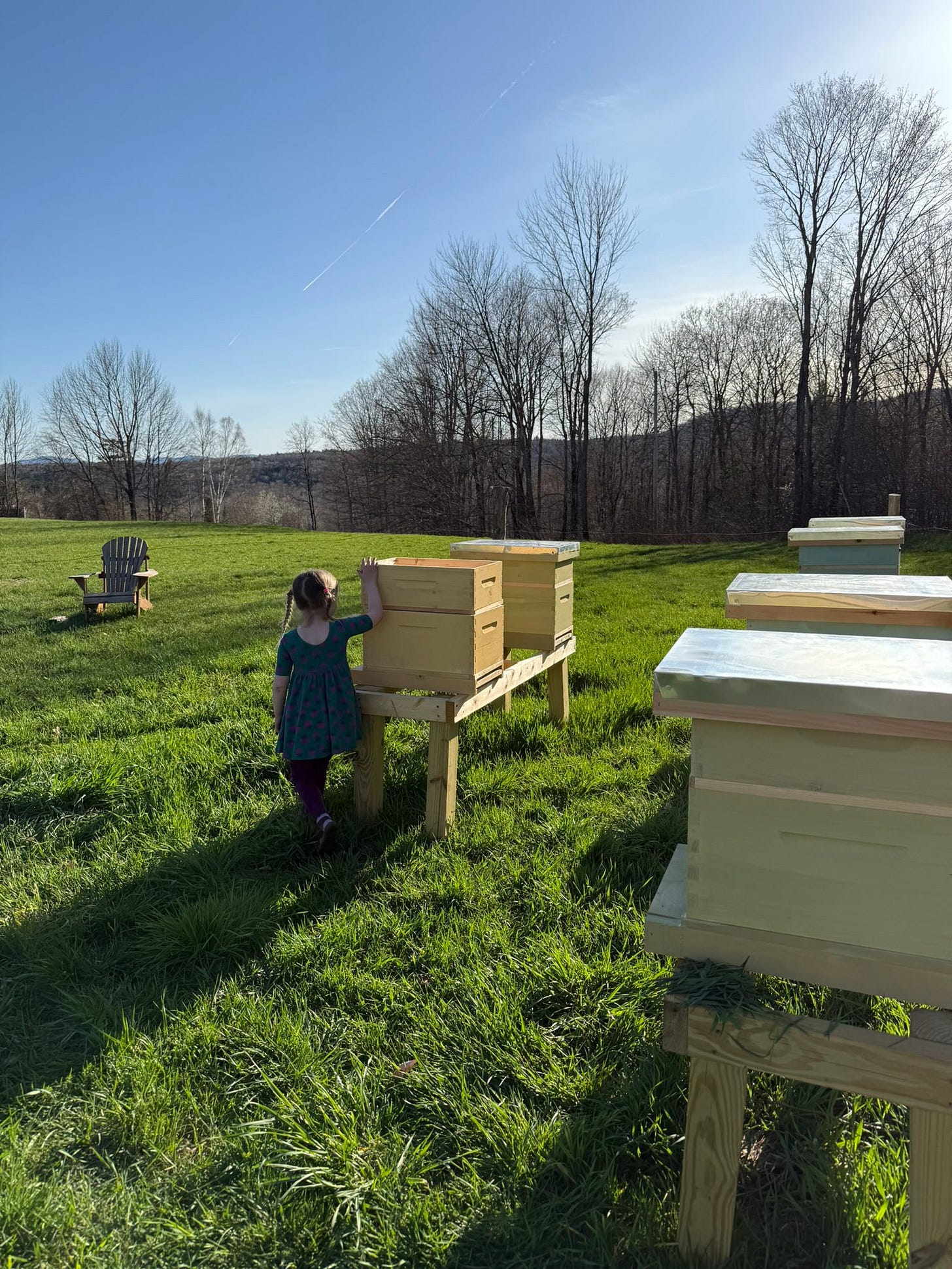Author’s Note: this essay is part of the Reports from the High Wood series, a weekly premium report from our homestead that offers you enduring lessons for living well in a wounded world. If you're drawn to green paths, perennial values, and timeless beauty that resists the modern glare, you're in the right place.
Thank you for being here with us.
Thousands upon thousands of wooden, enmeshed packages are being delivered to local post offices across the country this week, all containing something wonderful and strange.
Honey bees.
New and veteran beekeepers alike are rapidly, feverishly finalizing their apiaries, their bee yards, their hive bodies to receive these good golden workers. Amid all the spring chores, the garden, and baby animals being born, the need to paint and oil beehives is an easy task to put off. Any veteran beekeeper will tell you however that it is integral.
Recently I sent a friend a photo of our painted hives. She asked “Why do you paint them though? Seems like a lot of work.” As I was responding to her, I stopped and realized that my answers were not just practical reasons.
They were something more—much more. They were lessons on how to live life well.
Make Something Last
Beehives, like us, endure a great deal of abuse over their lifespans. When you paint a beehive, it extends the life expectancy of the soft pine wood of which it is comprised immeasurably. We live in a world of slick, greasy ease and disposable everything. This omnipresent disposability is a problem that seeps into our minds and subtly, insidiously causes us to view everything as disposable, including people and our relationships with them.
When you make something to last, or enhance something you have already built to last longer, you are rebelling against the greasy ease of our broken modern culture that whispers with a venomous tongue that “you can just buy something new, something better. It’s easier that way.” This rebellion is crucial.
Things made to last first require high quality materials. The act of gathering these materials is, in itself, an act that improves your life. Do you doubt this? Imagine building a box, a container to store heirlooms and artifacts. You could build this box with oriented strand board (OSB), or you could build it with maple. Find me a person who would earnestly feel more fulfilled, feel like they were living well, by building a box out of strand board. Impossible. Sure, we can explain why maple is better than something like plywood or OSB but there is an inexplicable feeling you get when you hold a stronger material. This is important and not to be rationalized away or discarded.
We lived this philosophy by using paint that had consisted of no volatile organic compounds, that consisted of no petroleum-based chemicals, that would not off gas and make my workshop smell like a cheap apartment ready to be leased. A high quality paint like this has a distinct advantage over whatever big brand you can get at the hardware store; you can let your children use it without fear.
The paint we used is comprised of milk proteins, lime, clay, and pigments. It comes in a powder. It does not have any strange symbols on the back of the can or instructions about which mortician to call if you get it in your eyes. It’s just old fashioned paint like what your ancestors used for centuries before industrialization.
My daughter dipped her brush in it and slapped it across the outer hive walls. “I got some in my hair!” she laughed. I corrected a dripping corner with a quick stroke and she proclaimed her job was to paint and mine was to smooth. I didn’t think then about the bees’ arrival, the battles against the mites and winter, the honey we’d harvest in the fall.
I thought about her, years from now, remembering this.
I hope she remembers we were relaxed. That we had fun. That the room smelled clean, not chemical. That the towers of green, white, yellow, and blue hives nearly touched the ceiling. That when she asked my favorite color, I told her it was the one she chose to paint that day. I found myself even hoping that one day, she'll paint hives with her own children and feel the same pride I do now.
When you choose to make something good—something that lasts—you allow yourself to dream for the future, for what your children might experience. You give them a conduit for their memories, something tactile. Your children can be transported back to the workshop with you, to those carefree days, by the smell of citrus or ammonia, by the feel of chalky paint on pine, by the sound of a marble rattling around a paint can. When you make something real, something tangible that lasts, you extend that durability, that endurance to the intangible aspects of the lives it touches as well. You make the memories a little more solid. You give your family a door by which to return.
When you build things to last, you choose patience over haste, craftsmanship over convenience, rootedness over disposability. You proclaim that tradition matters, that memory matters, that the people who come after you deserve something better than the greasy ease. In preserving the simple, solid things—whether hives, homes, or heirlooms—we preserve the conditions for a life well lived. In that preservation, we teach our children not only how to build, but how to hope, how to dream.
Author’s note: The lesson does not stop here. In the full essay below, we will explore two more enduring lessons gleaned from the apiary that apply to your life, from which you can learn.
If you have ever wanted to live more intentionally, more beautifully, more in tune with the perennial patterns that have shaped better lives, this essay is intended for you.
Reports from the High Wood is a place for that kind of reflection, for grounded wisdom in a wounded world. This is not just about bees or old sheds or tradition; it is about building a meaningful life from the roots up with dirt on your hands, hope in your heart, firefly light glimmering in your eyes. If that resonates with you, I would be honored if you joined as a subscriber and read the rest of this lesson.
Keep reading with a 7-day free trial
Subscribe to Echoes from an Old Hollow Tree to keep reading this post and get 7 days of free access to the full post archives.






